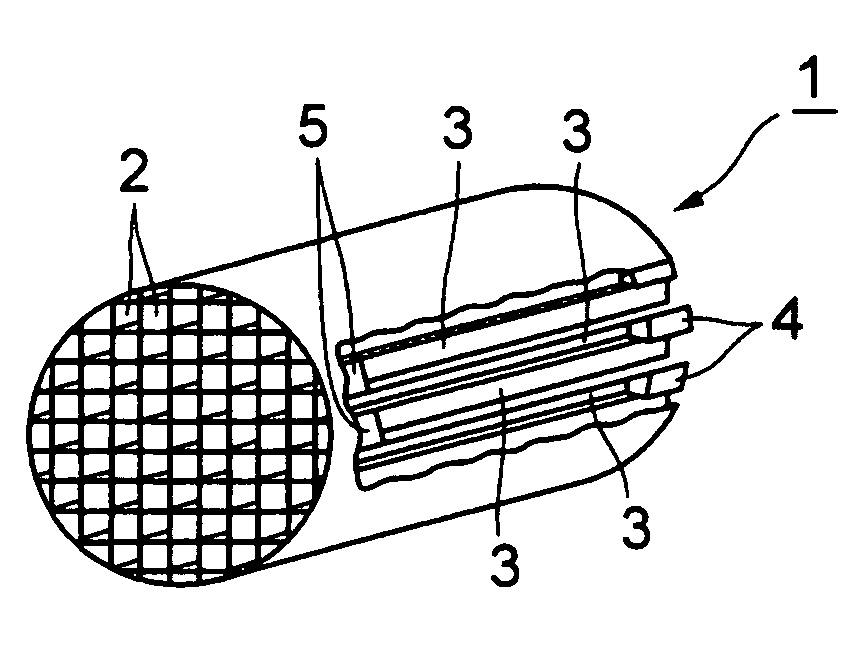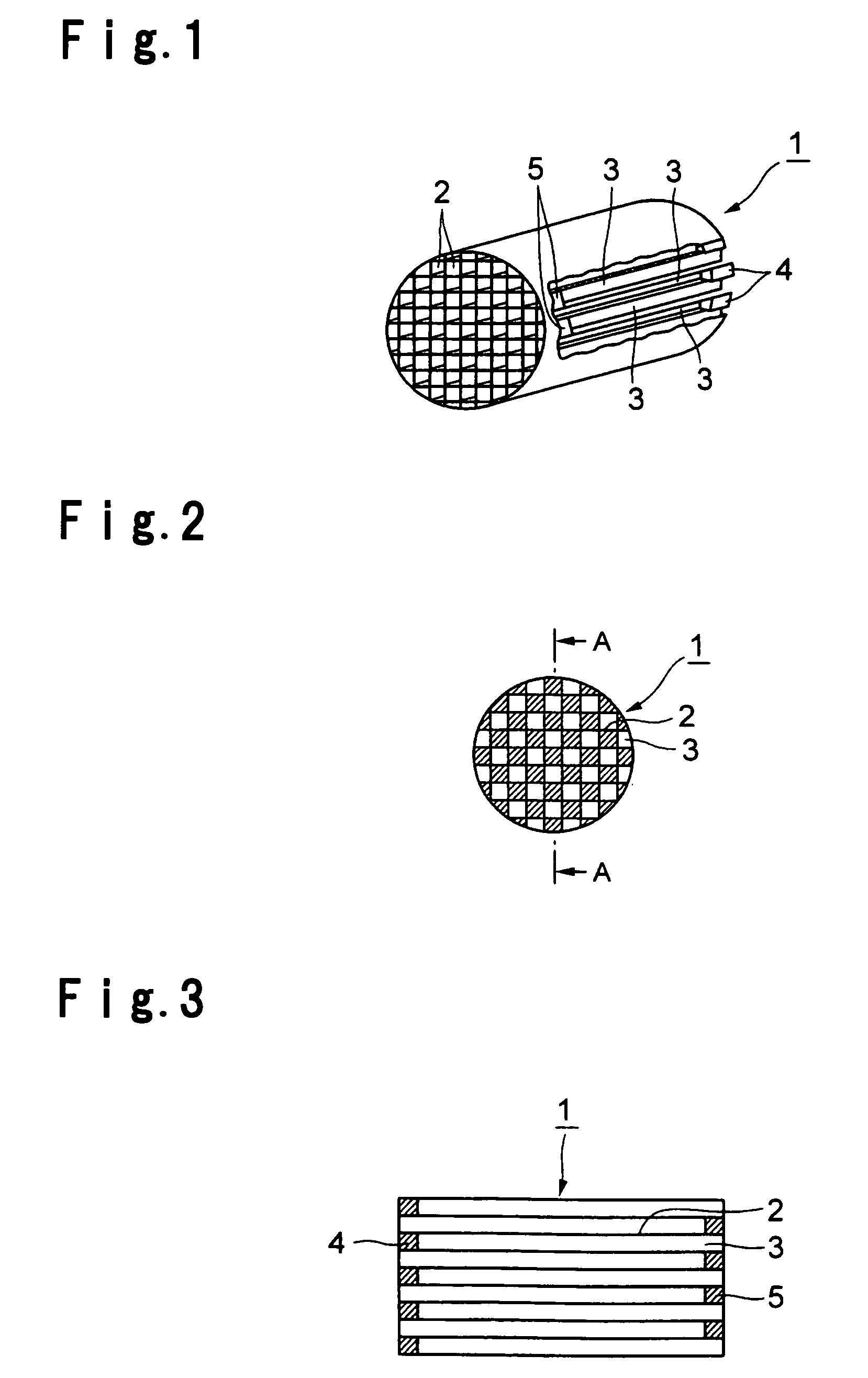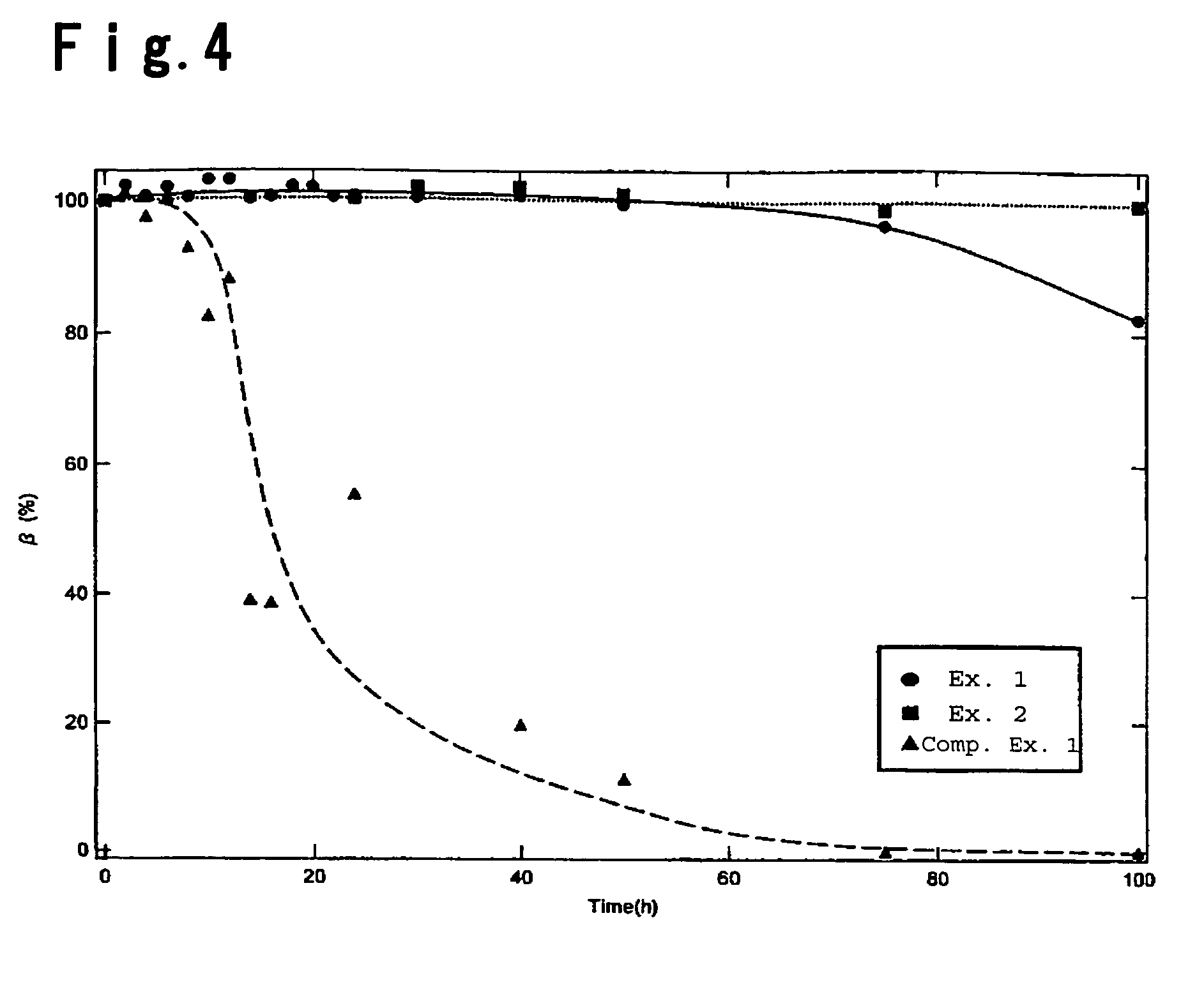Honeycomb filter for clarifying exhaust gas and method for manufacture thereof
a technology of exhaust gas and honeycomb, which is applied in the field of honeycomb filters, can solve the problems of material still having no adequate properties as exhaust gas filters, environmental problems, nitrogen oxides, etc., and achieve the effects of excellent heat resistance, small thermal expansion coefficient, and excellent thermal shock resistan
- Summary
- Abstract
- Description
- Claims
- Application Information
AI Technical Summary
Benefits of technology
Problems solved by technology
Method used
Image
Examples
example 1
[0053]To 100 parts by mass of a mixture comprising 56.1 mass % (50 mol %) of easily sinterable α-alumina and 43.9 mass % (50 mol %) of anatase-type titanium oxide, 4 parts by mass of an alkali feldspar represented by (Na0.6K0.4)AlSi3O8, 0.25 parts by mass of polyvinyl alcohol as a binder, 1 part by mass of diethylamine as a peptizer, 0.5 part by mass of polypropylene glycol as a defoaming agent, and 50 parts by mass of activated carbon having a particle size of from 50 to 80 μm as a pore-forming agent, were added, mixed for 3 hours in a ball mill and then dried in a dryer at a temperature of 120° C. for at least 12 hours to obtain a raw material powder.
[0054]The obtained raw material powder was pulverized to an average particle size of at most 10 μm and formed by a vacuum forming machine (manufactured by Miyazaki Iron Works Co., Ltd.) to obtain a honeycomb formed product. This formed product was dried and then fired in the atmosphere at 1,500° C. for 2 hours and then left to cool, t...
example 2
[0056]To 100 parts by mass of a mixture comprising 56.1 mass % (50 mol %) of easily sinterable α-alumina and 43.9 mass % (50 mol %) of anatase-type titanium oxide, 4 parts by mass of an alkali feldspar represented by (Nao0.6K0.4)AlSi3O8, 6 parts by mass of a spinel compound represented by a chemical formula MgAl2O4, 0.25 part by mass of polyvinyl alcohol as a binder, 1 part by mass of diethylamine as a peptizer, 0.5 part by mass of polypropylene glycol as a defoaming agent, and 50 parts by mass of activated carbon having a particle size of from 50 to 80 μm as a pore-forming agent, were added and mixed for 3 hours in a ball mill and then dried in a dryer at 120° C. for at least 12 hours to obtain a raw material powder.
[0057]Using the obtained raw material powder, pulverization, forming, drying and firing were carried out in the same manner as in Example 1 to obtain a honeycomb filter.
example 3
[0058]To 100 parts by mass of a mixture comprising 56.1 mass % (50 mol %) of easily sinterable α-alumina and 43.9 mass % (50 mol %) of anatase-type titanium oxide, 6 parts by mass of a spinel compound represented by a chemical formula MgAl2O4 as an additive, 0.25 part by mass of polyvinyl alcohol as a binder, 1 part by mass of diethylamine as a peptizer, 0.5 part by mass of polypropylene glycol as a defoaming agent, and 50 parts by mass of activated carbon having a particle size of from 50 to 80 μm as a pore-forming agent, were added and mixed for 3 hours in a ball mill and then dried in a dryer at 120° C. for at least 12 hours to obtain a raw material powder.
[0059]Using the obtained raw material powder, pulverization, forming, drying and firing were carried out in the same manner as in Example 1 to obtain a honeycomb filter.
PUM
| Property | Measurement | Unit |
|---|---|---|
| temperature | aaaaa | aaaaa |
| wt. % | aaaaa | aaaaa |
| porosity | aaaaa | aaaaa |
Abstract
Description
Claims
Application Information
 Login to View More
Login to View More - R&D
- Intellectual Property
- Life Sciences
- Materials
- Tech Scout
- Unparalleled Data Quality
- Higher Quality Content
- 60% Fewer Hallucinations
Browse by: Latest US Patents, China's latest patents, Technical Efficacy Thesaurus, Application Domain, Technology Topic, Popular Technical Reports.
© 2025 PatSnap. All rights reserved.Legal|Privacy policy|Modern Slavery Act Transparency Statement|Sitemap|About US| Contact US: help@patsnap.com



